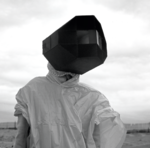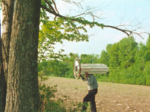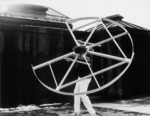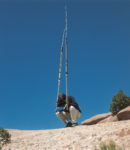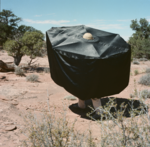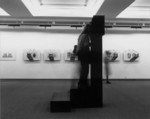
Sehmaschinen / Viewing Machines
Schillings Sehmaschinen zeigen neue Arten des Sehens auf. Es sind Apparaturen, die nicht unsere Sehorgane nur erweitern oder die strukturelle Leistungsfähigkeit des Auges bestätigen, sondern vielmehr spielerisch den Wahrheitsgehalt des menschlichen Blicks hinterfragen. Der Künstler fertigt die Apparaturen selbst, ihre Bandbreite reicht von simplen optischen Geräten bis zu aufwendigen vier Meter großen, schweren Holzrädern. Schillings Sehmaschinen führen in eine traumhafte Welt; blickt man durch sie etwa auf eine Naturlandschaft, wirkt diese fremd und vertraulich zugleich. Die Inversionsoptik dreht in der Vertikalen wie in der Horizontalen alles um, Perspektiven verschieben sich, Raumstülpungen lassen Objekte im Boden versinken, unsere gewohnten Sehweisen werden auf den Kopf gestellt.
Günther Oberhollenzer. Alfons Schilling: Künstler, Forscher, Visionär. Aus: Alfons Schilling. Ausstellungskatalog, Edition Sammlung Essl. Klosterneuburg, 2009. S.10
Klaus Albrecht Schröder: Mit den Augen eines Fremden. Die Sehmaschinen
Aus: Alfons Schilling. Ich / Auge / Welt. The Art of Vision. Springer-Verlag. Wien, New York, 1997. S. 205-209
Der Menschheit schwinden die Sinne: eine Erfahrung, die so alt ist wie die Industrialisierung. Mehr als jeder andere, war es der Sehsinn, an dem man schmerzhaft erkennen mußte, daß er der Beschleunigung des Lebens, dem Wachstum der Städte und der Industrialisierung des Reisens durch die Eisenbahn nicht länger gewachsen war. Das träge Auge kam mit der Beschleunigung der visuellen Erlebnisse und Eindrücke schlicht und einfach nicht mehr mit.
Mit jedem radikalen technologischen Innovationsschub sollte sich die Erfahrung der Unangemessenheit des Auges an die veränderte Wirklichkeit beziehungsweise an die veränderte Wahrnehmung der Wirklichkeit aufs Neue erweisen: von der ersten zur zweiten Industrialisierung und bis hin zu unserer Epoche der Digitalisierung von Informationen.
Wie die Wissenschaften reagierten auch die Künste auf den je neuen Stand - gleichsam als Sediment einer neuen Erfahrung. Helmholtz und Mach brachten wahrnehmungspsychologisch die Überwältigung des Sehsinns durch die Beschleunigung der Welt in eben jener Zeit auf den Begriff als Monet und Degas mit dem impressionistischen Sehen dieselbe Verflüchtigung der Realität durch deren radikale Subjektivierung ästhetisch protokollierten.
Der Wahrnehmungsschock, den die Erkenntnis der Durchlässigkeit der Materie durch die Entdeckung der Roentgenstrahlen und der Radioaktivität auslöste, findet wie die zeitgleiche Entdeckung des Unbewußten seinen Niederschlag in der Vergeistigung und Sublimierung der Realtität durch die Kunst des Expressionismus. Der Zweifel an der letztgültigen Wirklichkeit des Sichtbaren rührte auch und nicht zuletzt an der Glaubwürdigkeit des dafür zuständigen Organs.
Zuletzt hat die bildende Kunst in den 20er Jahren auf die zunehmende Rasanz der Fortbewegungsmittel sowie auf die neuen, ungewohnten Ansichten der Großstädte - von oben nach unten, von unten nach oben - mit dem fluktuierenden Blickwinkel der Kamera, der Collagetechnik und vor allem mit den avancierten Techniken des Schnitts und der Kameraführung im Film geantwortet: Spätestens in den 40er Jahren hat sich die Kunst aus diesem Prozeß der wechselseitigen Überbietung ausgeklinkt. Raoul Hausmann und Siegfried Kracauer haben noch in der Zwischenkriegszeit diese Phänomene sowohl soziologisch als auch wahrnehmungspsychologisch als eine Krise der Sinne beschrieben und mit der zunehmenden Abstraktheit in den gesellschaftlichen Beziehungen in Verbindung gebracht.
Immer schon war die künstlerische Arbeit an der Entfremdung der Sinne von der Wirklichkeit eine Arbeit an den Bildstrukturen, an der Gestalt des ästhetischen Objekts. Die Arbeit am Auge, die
technisch bewirkte Anpassungsleistung unseres Sehorgans an geänderte Anforderungen war und ist - arbeitsteilig - eine Sache der Wissenschaften, der Medizin.
Die künstlerische Arbeit von Alfons Schilling seit den späten 60er Jahren läßt sich nur verstehen, wenn man diesen Kontext bedenkt: das Auseinanderklaffen von alltäglicher Erfahrung und Wissen. Man verstünde Alfons Schillings Sehmaschinen grundsätzlich falsch, sähe man in ihnen einen Beitrag dazu, diese Kluft zu überwinden. Schillings Sehmaschinen sind Organkrücken, aber sie sind es nicht in einem affirmativen Sinn. Sie verbessern oder ersetzen keine Brille. Mit ihnen erzielt man keine teleskopische Wirkung, und sie leisten nicht, was jedes Schulmikroskop zu leisten imstande ist.
Und dennoch: Wer zum ersten Mal mit einem Elektronenmikroskop eine scheinbar vollkommen glatte und saubere Fläche betrachtet hat, ermißt die Überraschung, die einen überfällt, wenn man mit einem optischen Inversionsapparat von Alfons Schilling die Trümmer eines Steinbruchs ansieht: Man traut seinen Augen nicht. Nichts entspricht den Erwartungen, nichts deckt sich mit den jahrzehntelang eingefahrenen und eingeübten Eindrücken und Empfindungen.
Allein, da bleibt ein entscheidender Unterschied. Das Elektronenmikroskop macht etwas tatsächlich Vorhandenes sichtbar. Es ist lediglich eine Frage der Vergrößerung bis man die Risse und Schluchten in der spiegelglatten Politur einer Tischplatte ausmacht, eine Frage der Distanz, bis man das Leben der Milben entdeckt.
Damit haben die Sehmaschinen von Alfons Schilling nichts zu schaffen. Sie korrigieren nicht, sie erweitern nicht unsere Sehorgane; sie bestätigen nicht die strukturelle Leistungsfähigkeit des Auges, sie dementieren sie. Spielerisch und ephemer widerlegen sie die Wahr-Nehmung des Auges. Insofern ist das, was Alfons Schilling macht im emphatischen Sinn Nicht-Wissenschaft, allenfalls Forschung. Obwohl Schillings Arbeit auch dafür der semantisch und sozial verbriefte Nutzen, die Instrumentalisierbarkeit, mithin der potentielle Produktivitätsnachweis fehlt.
Ohne neue Welten zu erfinden - jahrhundertelang ein Hauptthema der Malerei, nicht nur der phantastischen -, führen uns Schillings Sehmaschinen in eine traumhafte Welt, die wir noch nie gesehen haben und zugleich wiedererkennen. Ihre maximale Wirkung erzielen die Sehmaschinen in der Natur. Doch würde man ihren Witz verkennen, begriffe man sie als Beitrag zur Gattung der Landschaftsmalerei. Im Gegenteil: Schillings Sehmaschinen spotten jeglicher Gattungskonformität: Denn jenseits aller Ikonographie ist es allein die Wirkung, auf die Schillings Kunst zielt. Nicht irgendein gegenständlicher Effekt überwältigt denjenigen, der mit einer Sehmaschische vor den Augen die triviale Landschaft durchwandert und dabei die Steine und Bäume, die Gräser und Zündhölzchen als wären sie Wunder betrachtet und bestaunt. Der Überraschungseffekt bezieht seine überwältigende, und schließlich auch erhellende und bewußtseinserweiternde Wirkung davon, daß nicht den Gegenständen und nicht dem optischen Instrument die Umkehrung allen Wissens, aller Erfahrung, aller Konventionen zugeschrieben wird, sondern den Augen.
Was wäre, wenn wir über einen anderen Sehsinn verfügten? Was sähen wir? Wie sähen wir? Wie dächten und empfänden wir? Ist die Welt, wie wir sie glauben, ein Wahn? Ist sie eine Möglichkeit unter vielen, nicht weil es auch andere Welten gibt oder geben könnte, sondern weil unser Sehsinn sie uns auf die uns vertraute Weise zugerichtet hat? Feuerbach hat uns gelehrt, daß die Götter ein Produkt unser Gesellschaft sind. Lehrt Schilling uns, daß die Welt ein Produkt unserer Sinne ist? Die auch anders aussehen, anders sein, anders organisiert sein könnte? Mit Schillings optischen Maschinen sieht man sich sehen und wird des Umstands gewahr, daß das Gesehene ein Ergebnis und Erzeugnis unserer Sinne ist. Kant wußte das und von der Unerkennbarkeit des Dinges an sich. Der vor die Augen gespannte Apparat Schillings ist die Struktur und die Theorie, das Modell und der Betrachter zugleich. Die Sehmaschine ist nichts als der verdinglichte Rezipient. In ihr begegnet der Mensch sich selbst. Die Selbstverständlichkeit, mit der wir uns in der Welt visuell zurecht finden, läßt uns vergessen, wie sehr unsere Sinne permanent ihre je eingene Welt konstituieren. Schillings Sehmaschinen demolieren diese Verblendung - auf poetische Weise.
Die Inversionsoptik wechselt in der Vertikalen wie in der Horizontalen alles. Sie spiegelt, was links ist nach rechts, sie stellt auf den Kopf, was in die Höhe ragt, sie holt nach vorne, was hinten ist, sie rückt in die Ferne, was in der Nähe sich befindet. Der Wassertropfen fällt nach oben, die Grube wird zum Hügel. So trivial die Raumumstülpungen sich anhören, so zauberhaft sind sie. Wer nie die Transformation eines gewöhnlichen Streichholzes in platter Quaderform mit rotem Schwefelköpfchen in ein fragiles, U-hakenförmiges Hölzchen mit einem zarten konkaven, nicht konvexen, Tröpfchen erlebt hat, kennt nicht die Poesie der Verfremdung. Die Grashalme, die nach unten wachsen, die Erde, die durchsichtig und gläsern über ihnen schwebt. Dies alles in einer kristallenen stereoskopischen Räumlichkeit, die uns zweifeln läßt, ob wir ansonsten überhaupt räumlich sehen. Die kleinen Stückchen Himmel zwischen den Blättern eines dicht belaubten Baumes schimmern nicht länger in weiter Ferne: Sie stehen als kompakte bläulich-weiße Pünktchen vor dem Laubwerk. Die knorrigen Äste sind kunstvoll und detailreich geschnitzte Hohlkörper - randlos. Die Vögel tauchen wie in gläsernem Quarz ins Gras hinunter.
Keine Beschreibung vermag die Schönheit und Lyrik dieser Eindrücke wiederzugeben. Fast anachronistisch möchte man Alfons Schilling zu einem nachgeborenen Romantiker machen, wäre dieser Begriff nicht durch hartnäckigen Mißbrauch korrumpiert und für den Kitsch der Kulturindustrie reserviert.
Hinzu gesellt sich wie zu jeder großen Kunst der Gegenwart einen Zuwachs an Erkenntnis, der der Trivialkunst eo ipso versagt ist. Wäre das intensive Erlebnis der durch eine Sehmaschine betrachteten Wirklichkeit nicht so unaussprechbar und überwältigend schön, es wäre schrecklich. Mich hat es über Tage und Wochen nicht ausgelassen; wann immer ich mir den Anblick der invertierten Wiese, des Steinbruchs, der Halme und Tiere vergegewärtige, überfällt mich eine Ahnung davon, wie sehr die von meinen Sinnen konstituierte Welt ein zufälliges Produkt, eine Laune meiner Augen ist. Nachdem ich einmal eine andere Möglichkeit des optischen Erlebens und der visuellen Aneignung der Wirklichkeit erfahren habe, weiß ich - nein: empfinde ich - wie sehr mein Denken von meiner optischen Ausstattung determiniert ist.
Oben und unten, hart und weich, undurchdringlich und transparent, das Statische und das Labile, das Aufgerichtete und das Fallende: All diese Kategorien sind multivalent. Ursprünglich optische werden sie zu sozialen Metaphern, zu moralischen Begriffen. Sie dringen in der visuell vertrauten Form in unser Weltbild, in unsere Denkweise.
Die Sehmaschinen verändern zwar scheinbar die Struktur des Gesehenen, wie Rodtschenko die Bildstruktur einer Fotocollage, aber nicht am Ende des Prozesses, sondern an seinem Anfang, an der Quelle. Es ist der Betrachter selbst, der das "Kunstwerk" konstituiert. Schilling emanzipiert das Werk von seiner Materialität. Damit festigt er wie in der Konzeptkunst - hier durch die Ersetzung des Werks durch seine Theorie - die Autorität des Rezipienten. Im gleichen Zug schwächt er sie, beraubt er doch diesen seiner kategorialen Gewißheiten.
Die Entmachtung des Objekts postuliert eine Originalität jenseits der Möglichkeit zu einem Original. Nicht länger existiert es. Jeder Betrachter schafft es sich jedesmal aufs Neue selbst, wenn er sich der Apparaturen bedient. Es ist erst Schillings Deklaration des spezifischen Erlebnisses als Kunst, die diesem seine Originalität bescheinigt.
Insofern sind die Sehmaschinen eine konsequente Fortsetzung der künstlerischen Intention Schillings seit jenen Scheibenbildern, die er 1962 in Paris angefertigt hat. Die Diskontinuität in der Entwicklung seiner Malerei entpuppt sich als Kontinuität in der identischen Arbeit am Bild-Begriff, an der Immaterialisierung des Bild-Objekts. Er wird von Alfons Schilling nicht länger von seiner Objektseite her analysiert und verändert, sondern vom Stellenwert, den das betrachtende Auge im Prozeß der Bildkonstituierung einnimmt. Alfons Schilling zerstört die Illusion, das Auge würde ein wie auch immer gestaltetes "Bild-Objekt" authentisch wiedergeben.
Die Geräte selbst, die Sehmaschinen, fertigt Schilling mit unterschiedlichem Aufwand. Von simplen optischen Geräten, die sich leicht seriell herstellen ließen, bis zu ästhetisch aufwendigen, vier Meter großen, schweren Holzrädern reicht die Bandbreite dieser spezifischen Objekte. Die durch Schillings Sehmaschinen gewonnene Erlebnisdichte ergreift den Körper in seiner Gesamtheit. Die Größe der Apparaturen und ihre schwere Handhabbarkeit erfüllen eine Doppelfunktion: Zum einen schaffen sie einen eigenen Raum für den Träger der Sehmaschine - eine eigene Aura, die von der Wirklichkeit mehr als nur körperlich distanziert. Es ist ein fiktiver, im engeren Sinn ästhetischer Raum, innerhalb dessen Schauen zum Ritual, dem schlechterdings Außeralltäglichen gerinnt. Zum anderen wird durch die Schwere des Objekts das Sehen zum psycho-physischen Vorgang. Die Übertragung der Motorik auf den Sehvorgang wächst diesem als Empfindungs-Steigerung zu. Sehen, von der Bewegung nicht zu trennen, ist physisch spürbar. Die Sehmaschinen sind aber trotz ihres Gewichts mehr als materielle Exponate. So sehr das "Kleine Rad", der "Dunkelkammerhut", die "Antilope" oder der "Ausgegrabene Vogel" als ästhetische Objekte faszinieren, so sehr ist Schillings eigentlicher Beitrag zur Kunst die Immaterialität des Noch-nie-Gesehenen. Die Sehmaschinen sind Protokolle der aktuellen Gefährdung des Auges, das sich zwischen kontrollierender Herrschaft und haltlosem Überwältigtsein hin und her bewegt, wo es nicht überhaupt starr vor Schrecken ist.
Schilling's classic visual devices such as the Little Wheel (1978), Big Wheel (1981), Littel Bird (1978), Darkroom (1984), Light Pump (1981), Exhumed Bird (1985/1986) were all optical "devices" so-called seeing machines. Because of the new mobility created by the ability to carry the device around, the viewer gained not only a visual but also a special motor experience. His movement was not only determined by the weight of the heavy mechanism, but especially by the striking visual phenomena. By using angular prisms or by means of a special arrangement of mirrors, for example, fore and background become interchanged. The artificiallity induced visual space offered the viewer a new visual dimension.
Romana Karla Schuler, Seeing Motion. Walter de Gruyter. Berlin/Boston, 2016. p 216
Klaus Albrecht Schröder: WITH FOREIGN EYES—THE VISION MACHINES
From: Alfons Schilling. Ich / Auge / Welt. The Art of Vision. Springer-Verlag. Wien, New York, 1997. pp. 205–209
Humanity can feel its senses failing: an experience that goes back as far as industrialization itself. More than any other, it was the visual sense that made us painfully aware that it was no longer up to the general acceleration of life, the growth of cities, and the industrialization of travel by railways. Plain and simple, the inert human eye was no longer able to keep up with the acceleration of visual experiences and impressions.
With every radical boost of technological innovation, the eye’s inadequacy in coping with an altered reality, or altered perception of reality, would manifest itself again: from the first to the second industrialization and up until our epoch of digitalized information.
Like the sciences, the arts also responded to the new situation—as if it were the sedimentation of a new experience. Hermann Helmholtz and Ernst Mach conceptualized in perceptual psychology terms the overwhelming of the sense of vision by the acceleration of the world at just about the same time when Monet and Degas, with Impressionist vision, recorded in aesthetic terms the same volatilization of reality through its radical subjectification.
The perceptual shock caused by the insight into the permeability of matter following the discovery of X rays and radioactivity finds expression, like the contemporaneous discovery of the unconscious, in the spiritualization and sublimation of reality by the art of Expressionism. Calling into doubt the ultimate reality of the visible affects not least the credibility of the organ in charge of it.
The last time that visual art responded to the increasing swiftness of vehicles of transportation and to new and unusual views of big cities—top down, bottom up—with fluctuating camera angles, collages, and above all with advanced editing and camerawork techniques in film was in the 1920s. In the 1940s, at the latest, art dropped out of this process of outdoing each other. Still in the interwar period, Raoul Hausmann and Siegfried Kracauer described these phenomena, sociologically and in perceptual-psychology terms, as a crisis of the senses, relating it to the increasing abstractness of social relations.
Artistic work on the estrangement of the senses from reality has always been work on pictorial structures, on the appearance of the aesthetic object. Work on the eye, the technical adaptation of our visual organ to changing requirements was and still is—in a division of labor—a matter of science, of medicine.
Alfons Schilling’s work in art since the late 1960s can only be understood against this context: the widening gulf between everyday experience and knowledge. It would be a fundamental misunderstanding of Schilling’s vision machines if they were seen as an effort to bridge that gulf. These machines are prosthetic organs, but not in any affirmative sense. They do not improve on, or replace, glasses. They don’t give a telescopic effect, and they don’t do what any classroom microscope does.
And yet: anybody who has ever seen an apparently perfectly smooth and clean surface under an electron microscope will be able to imagine the surprise that you are in for if looking at quarry rubble through an optical inversion apparatus of Alfons Schilling: you don’t believe your eyes. Nothing meets expectations, nothing coincides with decades of firmly set and practiced impressions and sensations.
However, one crucial difference remains. The electron microscope only makes visible what is actually there. It is merely a matter of magnification before the rifts and ravines in a high-gloss polished tabletop surface become discernible, a matter of distance before you discover the secret life of mites.
Alfons Schilling’s vision machines have nothing to do with any of that. They are not correctives, they don’t expand our visual apparatus, they don’t affirm the structural adaptability of the human eye, they disavow it. Playfully and in an ephemeral manner, they refute the idea of the irrefutable truthfulness of eyesight. Along these lines, what Alfons Schilling does is emphatically not science; at best, research. Even though Schilling’s work is still lacking semantically and socially certified usefulness, instrumentalizability, and hence potential proof of productivity.
Without inventing new worlds—for centuries a central subject of painting, not only fantastic painting—Schilling’s vision machines take us into a dreamlike world that we have never seen before and yet at once recognize. The maximum effect that the vision machines achieve is in nature. But we would be missing out on their inherent wit if taking them for a contribution to the genre of landscape painting. On the contrary: Schilling’s vision machines defy any genre conformity. For beyond all iconography what Schilling’s art aims for, first and foremost, is effect. It is not some objective representational effect that overwhelms those wandering a trivial landscape with a vision machine on front of their eyes, looking and marveling at stones and trees, grasses and matches like wonders. The surprise effect derives its overwhelming and eventually also enlightening and mind-expanding impact from the fact that the inversion of all knowledge, all experience, all convention is attributed not to the objects themselves nor the optical instrument, but to the human eye itself.
What if we had a different sense of vision? What would we be seeing? How would we be seeing? How would we think and feel? Is the world as we believe it to be but a mirage? Is it one possibility among many, not because there are, or might be, other worlds as well, but because our sense of vision has set it up for us in the one way that we are familiar with? Feuerbach has taught us that the gods are a product of our society. Does Schilling teach us that the world is a product of our senses? That it might look different, be different, be organized differently? Using Schilling’s optical machines, one sees oneself seeing and becomes aware of the fact that what is seen is a result and product of our senses. Kant knew that, and also knew about the unknowability of the thing-in-itself. Mounted in front of the eyes, Schilling’s apparatus is the structure and the theory, the model and the viewer, all at once. The vision machine is nothing but the objectified recipient. In it, the human meets itself. The matter-of-course manner in which we find our way in the world, visually, makes us forget how our senses are permanently constituting their own worlds. Schilling’s vision machines demolish this delusion—in a poetic style.
The image inversion optic switches everything around, vertically and horizontally. It reflects what is left to the right, it puts on its head what stands up tall, it brings to the fore what is in the back, it moves into the distance what is up close. A drop of water falls upward, a pit turns into a mound. As trivial as these spatial inversions may sound, as charming they are. Anybody who has never seen the transformation of a simple match, a flat rectangular shape with a red sulfur-head into a fragile U-shaped stick tipped with a tender concave, not convex, droplet does not know the poetry of defamiliarization. Blades of grass growing downward, the earth hovering above them, transparent and glassy. All this enveloped in a crystal stereoscopic spatiality that makes us doubt whether, otherwise, we see things spatially at all. Tiny specks of sky between the leaves of the dense foliage of a tree no longer glimmer in the distance: they stand out, as bluish-white dots, in front of the greenery. The gnarled branches are artfully and richly detailed carved hollow bodies—borderless. Birds swoop down into the grass like enclosed in glassy quartz.
No description can convey the beauty and the lyricism of these impressions. Almost anachronistically, one is tempted to call Alfons Schilling a late-born romantic, if the term were not compromised by persistent misuse and reserved as a label for culture-industry kitsch.
Adding to this, like to any great contemporary art, is a gain of insight that trivial art eo ipso cannot afford. If that intense experience of reality viewed through a vision machine were not so unspeakably and overwhelmingly beautiful, it would be horrifying. It kept haunting me for days and weeks; and whenever I recall to mind the view of the inverted meadow, quarry, grass blades, and animals, I get an inkling of the extent to which the world constituted by my senses is an accidental product, a vagary of my eyesight. Once I have experienced another possibility of optical intake and visual appropriation of the world I know—no, I feel—how my thinking is determined by my optical apparatus.
Top and bottom, hard and soft, impenetrable and transparent, the static and the unstable, the risen and the falling: all these are polyvalent categories. Originally optical, they turn into social metaphors, moral notions. They infiltrate, in their familiar visual form, our world view, our way of thinking.
The vision machines seemingly transform the structure of what is seen, like Rodchenko did with the pictorial structure of a photo collage, though not at the end of the process but at its beginning, at the source. It is the viewer himself who constitutes the “artwork.” Schilling emancipates the work from its materiality. He thus strengthens, like concept art—where this is done by replacing the work with its theory—the authority of the recipient. At the same time, he weakens it in that he divests recipients of their categorical certainties.
The disempowerment of the object postulates an originality beyond the possibility of an original. It exists no longer. Every viewer creates it anew every time when using the apparatuses. It only is Schilling’s declaration of the specific experience to be art that attests to its originality.
Seen this way, the vision machines are a consistent follow-up on Schilling’s artistic intention from the disk paintings he did in 1962 in Paris. The discontinuity in the development of his painting reveals itself as continuity in the identical work on the notion of the image, the immaterialization of the image object. Alfons Schilling no longer analyzes and transforms it from the object aspect, but from the position that the viewing eye has in constituting an image. Schilling utterly destroys the illusion of the eye giving an authentic representation of any given “image object.”
Making devices themselves, the vision machines, took Schilling varying degrees of effort. The build of these specific objects ranges from simple optical devices, which could be easily series-produced, to aesthetically demanding, four-meter wide, heavy wooden wheels. The density of experience gained through Schilling’s vision machines engages the body in its entirety. The size of the apparatuses and their unwieldiness served a twofold purpose: for one thing, they provide the wearer of the machine with a space of his own—an aura of his own that puts a more than just physical distance between him and reality. It is a fictitious, in a narrower sense aesthetic space inside which vision becomes a ritual, the very epitome of the non-everyday. On the other hand, the sheer weight of the object turns vision into a psycho-physical process. Coupling motor activity to the vision process adds to and heightens the visual sensation. Inseparable from motion, the act of vision becomes physically palpable. Despite their weight, however, the vision machines are more than just material exhibits. However fascinating the “Small Wheel”, the “Darkroom Hat,” the “Antelope” or the “Excavated Bird” may be as aesthetic objects, the real contribution that Schilling makes to art is the immateriality of the never-seen-before. The vision machines are evidence of the present-day jeopardy of the eye, vacillating between controlling dominance and being utterly overpowered, if not transfixed with sheer terror.
Translation: Michael Strand, Vienna
